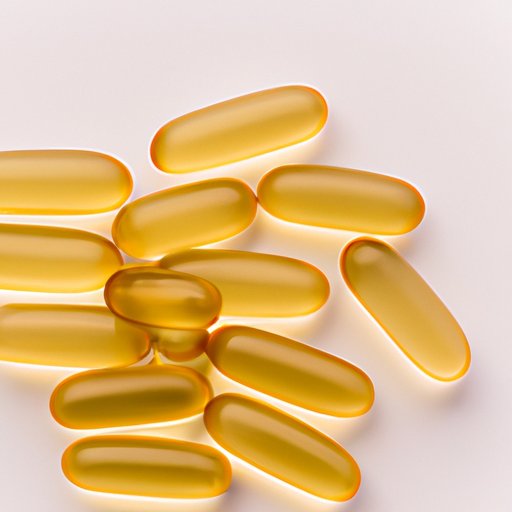
I. Introduction
Vitamin D is crucial for overall health and wellbeing. It helps with regulating calcium levels in the body, strengthening bones, boosting the immune system, and reducing inflammation. In this article, we’ll take a closer look at what exactly Vitamin D is, the role it plays in our health, as well as the importance of maintaining proper intake levels.
II. The Importance of Vitamin D: Understanding its Role in Our Body’s Health
Vitamin D is a fat-soluble vitamin that plays a crucial role in overall body function. It is primarily responsible for regulating calcium and phosphorus levels in the body, essential for developing and maintaining strong bones and teeth. In addition, it helps with reducing inflammation, boosting the immune system, and reducing the risk of chronic diseases such as cancer, diabetes, and heart disease.
Studies have even shown that adequate Vitamin D levels can help in preventing depression, improving brain function, and reducing the risk of autoimmune diseases such as Multiple Sclerosis and Rheumatoid Arthritis.
However, Vitamin D deficiency is becoming an increasingly common problem, particularly in areas with limited sun exposure or for those who have a strict vegan diet.
III. Vitamin D Deficiency: Symptoms, Causes, and How to Get More of It
Vitamin D deficiency can cause a range of symptoms, including bone and muscle pain, weakness, fatigue, and stunted growth in children. It has also been linked to an increased risk of chronic diseases, such as osteoporosis, heart disease, and diabetes.
The causes of Vitamin D deficiency can be due to lifestyle choices such as spending too much time indoors, living in areas with limited sun exposure, or having an imbalanced diet that lacks Vitamin D-rich foods. Those who have darker skin tones and older adults are also at a higher risk of becoming deficient in Vitamin D.
Incorporating more Vitamin D into your diet can be done through a variety of ways. Eating foods such as fatty fish, dairy, and egg yolks can help bump up your intake levels. Supplements are also available, and these are useful for those who can’t get enough through their diet. Sun exposure is also a good source of Vitamin D, but it is essential to practice safe sun exposure to avoid overexposure to harmful UV rays.
IV. Daily Dosage and Safe Vitamin D Intake: A Guide to Maintaining Optimal Health
It is recommended that adults get between 400-800 IU of Vitamin D per day to maintain optimal levels. However, individual needs may vary, and some people may require higher doses to compensate for their deficiency. It’s crucial to note that taking too much Vitamin D can lead to toxicity, which can cause symptoms such as nausea, vomiting, and kidney damage.
It’s important to consult with a healthcare professional before starting any new Vitamin D supplementation regime to determine appropriate dosage and ensure proper intake. Those who have a Vitamin D deficiency may require higher doses to bring their levels back to normal ranges.
V. The Top 10 Foods Rich in Vitamin D: How to Plan a Balanced Diet
Eating a balanced diet that includes Vitamin D-rich foods can help maintain optimal levels of this crucial vitamin. Some of the best food sources of Vitamin D include fatty fish such as salmon and tuna, egg yolks, mushrooms, and fortified foods such as milk and orange juice.
Here are the top 10 foods rich in Vitamin D and how much is in each serving:
1. Salmon (3.5 ounces) – 447 IU
2. Tuna (3.5 ounces) – 154 IU
3. Egg yolks (1 large egg) – 41 IU
4. Mushrooms (1 cup) – 400 IU
5. Fortified cow’s milk (1 cup) – 120 IU
6. Fortified soy milk (1 cup) – 107 IU
7. Fortified orange juice (1 cup) – 120 IU
8. Sardines (3.5 ounces) – 272 IU
9. Beef liver (3.5 ounces) – 50 IU
10. Cod liver oil (1 tablespoon) – 1,360 IU
Incorporating these foods into a balanced diet can help ensure proper intake levels of Vitamin D.
VI. Vitamin D and Sun Exposure: Finding the Right Balance for a Healthy Lifestyle
Sun exposure is a natural and effective way to get Vitamin D, as the body can synthesize it when exposed to sunlight. However, over-exposure to the sun can lead to skin damage and an increased risk of skin cancer.
Those who wish to get Vitamin D from the sun should practice safe sun exposure methods, such as spending time outside during the early morning or late afternoon when UV rays are less intense, wearing protective clothing, and always using sunscreen.
Alternative ways to get Vitamin D include using a lightbox or sunlamp, which can be a suitable option for those who have limited sun exposure. Supplementing with Vitamin D capsules or gummies can also be effective in increasing levels.
VII. Conclusion
Incorporating adequate amounts of Vitamin D into your diet and getting enough sun exposure can go a long way in ensuring overall health and wellbeing. Vitamin D plays a crucial role in many body functions, and maintaining adequate levels can help reduce the risk of chronic diseases and other health issues. Consult with a healthcare professional to determine specific supplementation needs and always practice safe sun exposure methods to avoid skin damage.
Remember that a balanced diet and healthy lifestyle are essential in maintaining optimal health, so pay attention to your Vitamin D intake and make healthy choices every day.





